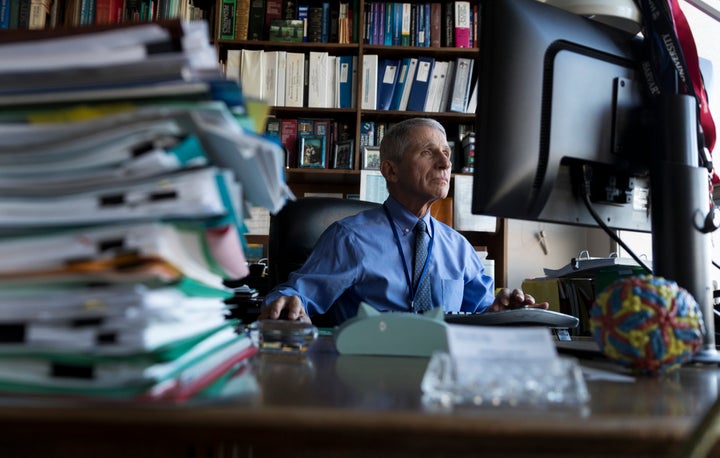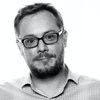Anthony Fauci has run the National Institutes of Health’s infectious diseases agency since Ronald Regan was president and has played key roles in virtually every public health intervention and policy since then. That is, until his candor about the novel coronavirus pandemic contradicted President Donald Trump’s falsehoods.
For months, the White House largely disregarded Fauci’s advice. Trump, his allies and right-wing media painted the soft-spoken Brooklyn native as a villain. Trump repeatedly threatened to terminate Fauci’s employment (something he can’t really do). Crowds at Trump rallies chanted “Fire Fauci!” Former Trump adviser Steve Bannon said Fauci should be executed and his head placed on a pike on the White House grounds.
But Fauci has kept a relentless pace trying to correct the country’s coronavirus course.
“Each day is different,” Fauci told HuffPost in an interview on the day before Thanksgiving. “It’s just, you know, drinking out of a firehose trying to keep ahead of everything that’s going on.”
The night before, he’d been awake until around 11 p.m. sorting through a mountain of email until he was too tired to continue. “I get like over a thousand emails a day and when they screen it, they screen it down to those few hundred that I have to deal with,” he said. “Then you have a day that is wall-to-wall, literally.”
He was back up at 5:10 a.m. on Wednesday, facing a day with a mere 20 minutes of unscheduled time. He expected to lose that break as new business arose over the course of the day.
With a national holiday on the horizon, the biggest portion of his 18-hour workday was to be spent doing press.
Here’s what Fauci’s Thanksgiving eve looked like.
5:10 a.m. to 6 a.m. Showered and shaved
6 a.m. to 6:30 a.m. Resumed dealing with email
6:30 a.m. to 7 a.m. Appeared on ABC News’ “Good Morning America”
7 a.m. to 7:30 a.m. Left home for NIH
7:30 a.m. to 8 a.m. Appeared on C-SPAN’s “Washington Journal”
8 a.m. to 8:30 a.m. Appeared on WNYC-FM’s “The Takeaway”
8:30 a.m. to 9 a.m. Interview with Chicago television station
9 a.m. to 10 a.m. Visited two severe COVID-19 patients under treatment at the NIH Clinical Center and their primary physicians
10 a.m. to 10:30 a.m. Video meeting with senior National Institute of Allergy and Infectious Diseases staff
10:30 a.m. to 11:00 a.m. Interview with newspaper reporter
11:00 a.m. to 11:50 a.m. Video meeting with Health and Human Services Secretary Alex Azar, NIH Director Francis Collins, CDC Director Robert Redfield, FDA Administrator Stephen Hahn and other health officials
11:50 a.m. to 12 p.m. A bathroom break and more email
12 p.m. to 12:30 p.m. Interviewed with Byron Allen for theGrio on skepticism about the vaccine among Black Americans
12:30 p.m. to 1 p.m. HuffPost interview
1 p.m. to 1:30 p.m. Another television appearance
1:30 p.m. to 1:50 p.m. The elusive scheduled break
1:50 p.m. to 2:30 p.m. Another newspaper interview
2:30 p.m. to 3 p.m. Interview with scientific journal
3 p.m. to 3:30 p.m. Prep for an upcoming speech to “the centers for science and international something-or-other, one of those think tanks in Washington”
3:30 p.m. to 4:30 p.m. Video meeting with White House Coronavirus Task Force
4:30 p.m. to 5:30 p.m. Video meeting with NIH vaccine scientists
5:30 p.m. to 7 p.m. Responding to phone calls
By 7 p.m., he hoped to be on his way home, where his day would end with a 45-minute power walk alongside his wife, Christine Grady, a nurse and the chief of the Department of Bioethics at the NIH’s Clinical Center. Then, he planned to have dinner followed by more calls and emails until he couldn’t keep his eyes open.
“I don’t socialize. It’s my wife and I and the federal agents. We’ve sort of become like a new family unit.”
- Dr. Anthony Fauci
There’s not much room for a personal life these days. Fauci doesn’t ride Washington’s Metro or run errands. He hasn’t attempted to safely socialize with friends or family. His adult children didn’t come home for Thanksgiving this year, as he’d begged others not to do as well. The extent of his indulgences is ordering takeout.
He can’t afford to contract the disease he spends his days fighting. “One, because nobody wants to get infected, but two, I really have an important job that I’d hate to be laid up for because I got infected,” he said.
But he and Grady have also become more cautious amid the violent rhetoric from Trump and other conservatives, which has included death threats and harassment.
“I have federal agents that protect me. So they drive me to work, they stay here, they make sure that nobody tries to break in [to my home] and, as Steve Bannon would like, have somebody behead me,” Fauci said. “I don’t socialize. It’s my wife and I and the federal agents. We’ve sort of become like a new family unit.”

Fauci’s Day Job
Even a detailed recounting understates the fullness of Fauci’s days. He uses two laptops for his many video calls and a technician logs him into the next meeting while he’s attending the current one. He swaps computers and carries on, barely missing a beat.
In the middle of his conversation with HuffPost, he received a text from the White House that required a call back after the interview, jeopardizing the rest of his schedule and threatening to take away the only 20 free minutes he had all day. (It also may have changed in any number of ways after his HuffPost interview.)
Fauci is used to this kind of unrelenting rigor. He did it through the Ebola outbreak from 2014 to 2016 and during the creation of major health initiatives, like President George W. Bush’s President’s Emergency Plan For AIDS Relief.
Even during crises, there are the regular day-to-day operations of the National Institute of Allergy and Infectious Diseases he must oversee as director. The 2,000-person agency finances and conducts biomedical research, and its nearly $6 billion budget is the second-largest in the NIH, behind only the National Cancer Institute.
Fauci also helps coordinate U.S. federal policy with state, local and foreign governments, and personally leads the NIAID’s Laboratory of Immunoregulation, overseeing a team of scientists. He writes and publishes scientific journal articles. He treats patients at the NIH’s Clinical Center. He’s a coveted speaker at scientific and health care conferences. And he’s an experienced and effective public communicator on science and medical issues in high demand from journalists.
Fauci steps back from day-to-day management of the NIAID and his lab at crisis points like the one we’re in now, putting more responsibility on the team he’s spent 36 years assembling.
“It’s much more likely that I would have to do that compared to other institute directors because by the nature of the discipline that they’re responsible for,” he said. “You don’t usually have acute emergencies in endocrinology or acute emergencies in cardiology or acute emergencies in genetics. But you do have acute emergencies in infectious diseases.”
He also has to sacrifice his scientific endeavors, spending less time researching, writing and keeping up with the latest scientific literature.
As he enters his ninth decade, Fauci isn’t in a hurry to slow down. On Thursday, he told CBS News that he plans to stay on at the NIH under the Biden administration, which has made the pandemic response its top priority. If anything, Fauci’s responsibilities are likely to increase under a president not inclined to deny the seriousness of the outbreak.
- Which airlines are blocking out middle seats for holiday travel?
- How does the coronavirus spread differently than the flu?
- Can you close your COVID “bubble” without losing friends forever?
- Is it safe to see grandparents over the holidays?
- How can you help a friend with anxiety when you’re also struggling?
Everyone deserves accurate information about COVID-19. Support journalism without a paywall — and keep it free for everyone — by becoming a HuffPost member today.

